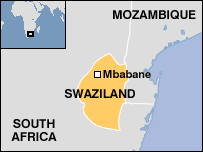“A
generation is going to its grave long before its time, leaving its children
orphans and carrying the seeds of their own destruction.” -Michael Burek (BBC news in Swaziland)
In
2004, the UN AIDS envoy declared Swaziland the country with the
highest HIV infection rate in the world.
AIDS—the number one killer in Swazi—is wiping out entire generations,
orphaning children to nearly one third of the entire population being without
parents, and could possibly lead to the country’s ultimate demise. The government (monarchy) has taken some
steps in addressing this problem…but not enough…
 King
King
Mswati III crowned in 1986 as an 18 year old, forbid men in 2001 from sleeping
with teenage girls. Yet, one of the
culture practices is called the “reed dance” where thousands of women dance
before the king, and he picks his wives.
King Mswati currently has ten wives, while his father had 100. Much of the man is “measured by how many
women and children he has” (Burek, BBC News).
The government also promised an injection to stop the transfer of HIV from
pregnant mother to child; however, it is not made available to everyone,
everywhere, and is “far too late.”
While
most Swazis live in chronic poverty and while food shortages are widespread,
much of the money/funding in this country goes to the king himself. King Mswati, also know as “Ngweyama” (the
lion) has been criticized for requesting public money to pay for new palaces, a
public jet, and luxury cars. The economy
of Swaziland depends significantly on South Africa.
Some
other facts about Swaziland include the following:
- It is one of the world’s last remaining absolute
monarchies
- It is homogenous with most of the population being
from the same tribe - the main religions are Christianity and indigenous
beliefs - the official languages are English and siSwati
- the currency is 1 Lilangeni=100 cents
- Capital: Mbabane
- 60-86% of the population are Christian (depending
on the source) - number of telephones per 1,000 people= 31
- number of motor vehicles per 1,000 people= 83
- traditionally, Swazis’ occupations are subsistence
farmers and livestock herders - There are over 100,000 orphans in the 1.1 million
population - ONLY one in ten children make it to the age of 30
Check
out the following sources for more information on Swaziland:
http://encarta.msn.com/encnet/refpages/RefFAF.aspx?refid=631504869
http://www.state.gov/r/pa/ei/bgn/2841.htm
http://news.bbc.co.uk/2/hi/africa/








